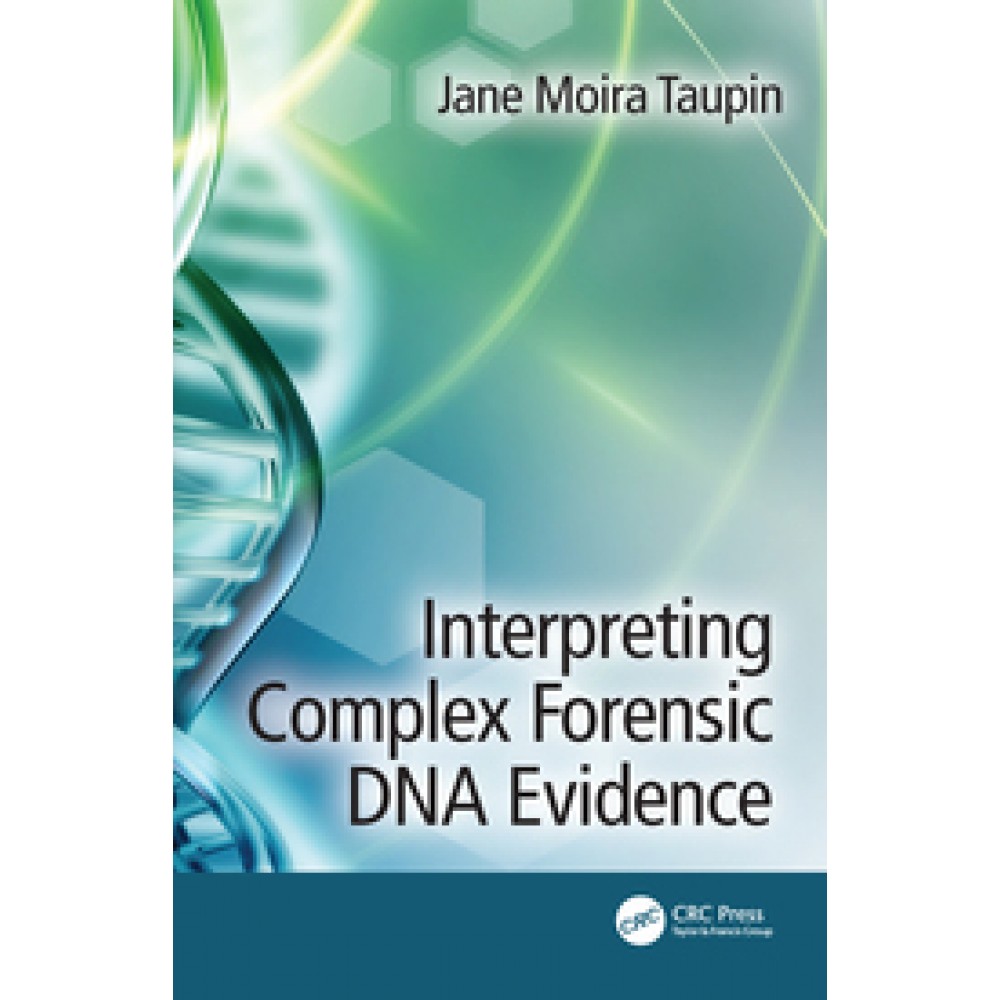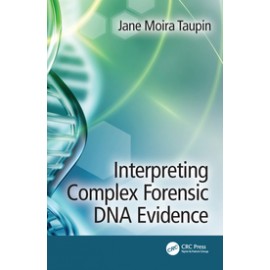Interpreting Complex Forensic DNA Evidence - Jane Moira
Descripcion del producto
ISBN 9781138495678Published December 2, 2019 by CRC Press178 Pages 10 B/W Illustrations
Interpreting Complex Forensic DNA Evidence is a handy guide to recent advances?and emerging issues?in interpreting complex DNA evidence and profiles for use in criminal investigations. In certain cases, DNA cannot be connected to a specific biological material such as blood, semen or saliva. How or when the DNA was deposited may be an issue. The possibility of generating DNA profiles from touched objects, where there may not be a visible deposit, has expanded the scope and number of exhibits submitted for DNA analysis.
With such advances, and increasing improvements in technological capabilities in testing samples, this means it is possible to detect ever smaller amounts of DNA. There are also many efforts underway to seek was to interpret DNA profiles that are sub-optimal?either relative to the amount required by the testing kit and, potentially, the quality of the obtained sample. Laboratories often use enhancements in order to obtain a readable DNA profile.
The broad-reaching implications of improving DNA sensitivity have led to this next, emerging generation of more complex profiles. Examples partial profiles that do not faithfully reflect the proposed donor, or mixtures of partial DNA from multiple people. A complexity threshold has been proposed to limit interpretation of poor-quality data. Research is now addressing the interpretation of transfer of trace amounts of DNA. Complex issues are arising in trial that need to be reconciled as such complexity has added challenges to the interpretation of evidence and its introduction or dismissal in certain cases in the courts.
Key Features:
- Addresses DNA transfer, from person-to-person as well as to objects
- Outlines each stage required to produce a DNA profile from an exhibit?including collection, handling, storage, and analysis
- Discusses ethics, subjectivity, and bias?including cognitive dissonance?as they relate specifically to complex DNA evidence
- Highlights current techniques and the latest advances in DNA analysis, including advances in familial DNA searches
Interpreting Complex Forensic DNA Evidence provides tools to assist the criminal investigator, forensic expert, and legal professional when posed with a DNA result in a forensic report or testimony. The result?and any associated statistic?may not reveal any ambiguity, complexity, or the assumptions involved in deriving it. Questions from resolved criminal cases are posed, and the relevant forensic literature, provided for the reader to assess a DNA result and any associated statistic. Case studies throughout illustrate concepts and emphasize the need for conclusions in the forensic report that are supported by the data.
Table of Contents
Preface ? Aims and Scope
Acknowledgements
About the Author
Chapter 1 Complex DNA evidence
1.0 Introduction
1.1 Simple versus complex DNA evidence
1.2 Increased sensitivity
1.3 Increased technology
1.4 Uncertainty
1.4.1 Illusion of scientific certainty
1.4.2 DNA profile ?match?
1.5 History of exhibit or provenance and context
1.6 Trace DNA
1.7 Conclusion
1.8 References
Chapter 2 Complex DNA profiles
2.0 Introduction
2.1 The derivation of a DNA profile
2.2 How long does it take to obtain a DNA profile?
2.3 DNA profile comparison
2.3.1 Simple single source DNA profiles
2.3.2 The sex marker amelogenin
2.3.3 Autosomal markers
2.3.4 Artifacts
2.3.5 Stutter
2.3.6 Degraded DNA profiles
2.3.7 Inhibited DNA profiles
2.4 DNA mixture profiles
2.4.1 Number of contributors
2.4.2 Complex DNA mixtures
2.5 Low level DNA and partial DNA profiles
2.5.1 Stochastic effects
2.5.2 Repeat analysis
2.6 Dropout
2.7 Dropin
2.8 Complexity threshold
2.9 Enhanced interrogation
2.10 Direct PCR
2.11 Rapid DNA
2.12 References
Chapter 3 Statistical evaluation of complex DNA evidence
3.0 Introduction
3.1 Statistical interpretation and wording
3.2 Errors during analysis
3.3 Errors of interpretation or in conveying the statistical meaning
3.3.1 Transposition of the conditional
3.3.2 Association error
3.4 Statistics ? weight of evidence for DNA profiles
3.4.1 Likelihood ratio
3.4.2 Formulation
3.4.3 Framework of propositions
3.4.4 Binary to continuous models
3.5 Probabilistic reasoning
3.5.1 Variability between systems
3.5.2 Variability within the same system
3.5.3 Application to the real world
3.5.4 Specificity
3.5.5 Validation
3.5.6 Open source versus closed source
3.6 Hierarchy of propositions
3.7 Fallacious reasoning
3.7.1 Assumption of independence
3.7.2 Combining multiple pieces of diverse evidence
3.8 References
Chapter 4 Transfer
4.0 Introduction
4.1 Transfer principles
4.2 Trace DNA
4.3 Trace DNA transfer
4.4 Tertiary and higher levels of transfer
4.5 Persistence, prevalence and recovery
4.5.1 Persistence, prevalence and recovery in context
4.5.2 Persistence
4.5.3 Prevalence and ?background DNA?
4.5.4 Non-self DNA
4.5.5 Detection and recovery
4.6 Skin
4.6.1 Skin DNA
4.6.2 Shedder status
4.7 Hands and fingernails
4.7.1 Hands
4.7.2 Fingernails
4.8 Wearer DNA
4.9 Investigator mediated transfer
4.10 Extrapolating experimental data to casework
4.11 Direct versus indirect transfer estimations
4.12 References
Chapter 5 Integrity
5.0 Introduction
5.1 Documentation
5.2 The scene environment
5.3 Personal protection equipment
5.4 The mortuary
5.5 Packaging, handling and transport
5.6 Crime scene laboratories
5.7 Fingerprint laboratories
5.8 Forensic laboratory examination
5.9 Staff reference samples
5.9.1 Laboratory staff contamination
5.9.2 Police staff contamination
5.10 History
5.10.1 Laundering of clothing and other fabric items
5.11 Controls
5.12 References
Chapter 6 Familial DNA searching
6.0 Introduction
6.1 Searching DNA databases
6.2 Familial DNA searching
6.2.1 Introduction of familial DNA searching
6.2.2 Techniques used
6.3 SNP testing
6.4 Ancestry DNA testing
6.5 Long range or extended familial DNA searching
6.6 Forensic DNA phenotyping and epigenetics
6.7 Rogue DNA databases
6.8 References
Glossary of terms
Author(s)
Biography
Jane Moira Taupin is an independent forensic science consultant and trainer. She earned her MA in criminology from the University of Melbourne, Parkville, Victoria, Australia. Her thesis on the impact of DNA profiling was one of the first in the field. She has presented biological expert evidence in courts of law and DNA profiling evidence in court. She has published many articles in peer-reviewed journals on trace evidence, clothing damage and blood pattern analysis. She has also co-authored a text on the forensic examination of clothing and is the author of another on DNA profiling in criminal cases for the legal and forensic communities. She has received several awards in recognition and support of her work from national and international sources.



